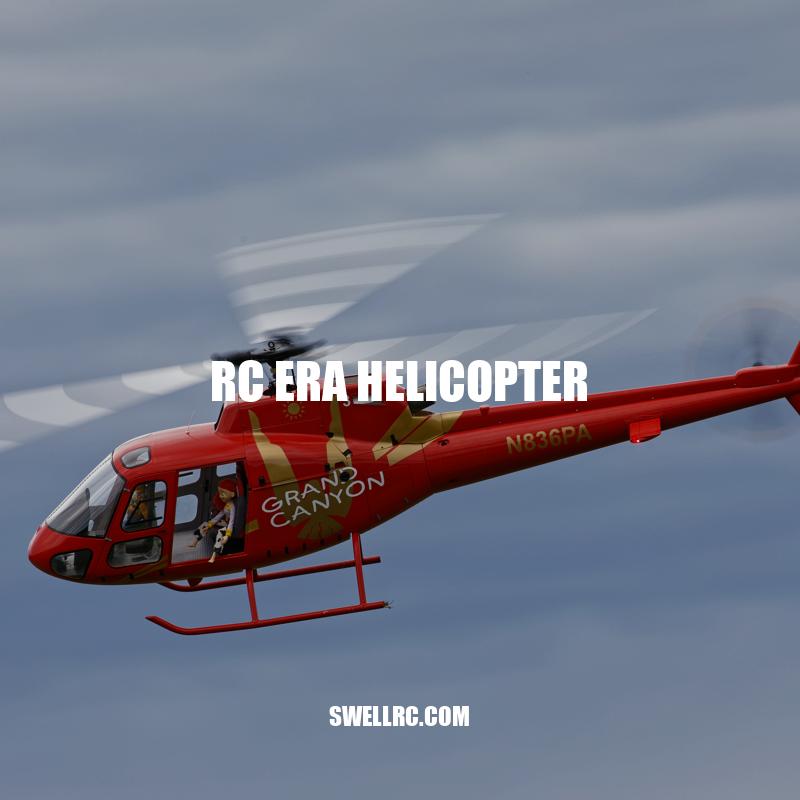RC Era Helicopters: Evolution, Types, and Tips
Remote control (RC) helicopters have been fascinating hobbyists and enthusiasts since the 1960s. With the advancements in technology over the years, RC helicopters have evolved to a great extent, making them more advanced, versatile, and easier to control. Unlike earlier versions, today’s RC helicopters boast of advanced features, such as GPS, high-definition cameras, and advanced control settings. RC helicopters have become popular not just as toys but also as a tool for professional and commercial users. From aerial photography and surveys to rescue missions and military operations, RC helicopters have proven to be a valuable asset for various fields. However, despite their growing popularity, flying an RC helicopter still requires a lot of skill and patience. In this article, we will explore the history, types, instructions, and maintenance of RC helicopters, providing you with a comprehensive guide to this fascinating hobby.
History of RC Era Helicopter
RC helicopters have been around for over six decades and have come a long way since their inception. The first RC helicopter model was built in the 1960s and was difficult to control, but subsequent advancements made them more accessible to hobbyists. Here are some significant milestones in the history of RC helicopters:
- Early models of RC helicopters were designed with fixed-pitch blades that required a lot of skill to control.
- From the 1970s, collective pitch designs with flybar stabilization were introduced, making RC helicopters more stable and easier to fly.
- Advances in remote-control technology in the 1980s allowed for more precise control and the introduction of micro helicopters.
- In the 1990s, electric-powered helicopter models became popular, replacing the traditional fuel-powered helicopters.
- The new millennium brought in advanced designs and features such as GPS and High-Definition cameras, making RC helicopters more versatile and useful in commercial applications.
Today, RC helicopter enthusiasts can purchase hobby-grade RC helicopters in various sizes and styles, including ready-to-fly models to build-it-yourself kits. With the help of online resources, including RC helicopter forums, tutorials, and instructional videos, flying and maintaining RC helicopters has never been easier.
When was the first RC helicopter made?
The first practical helicopter was designed by Igor Sikorsky in the late 1930s. The first fully controllable RC model helicopter was built by Dr Dieter Schluter about forty years later in the early 1970s. It was then that the model helicopter kits became available for purchase by the public.
Types of RC Era Helicopter
RC helicopters come in different types, suited for different uses, such as photography, racing, and military operations. Below are the most common types of RC helicopters:
| Type | Description | Pros | Cons |
|---|---|---|---|
| Coaxial | Two sets of rotors designed to counteract each other | Very stable, easy to fly, and good for beginners | Not as maneuverable as other types, limited to indoor flying |
| Collective Pitch | Rotors use a collective pitch system that allows for more control and maneuverability | More versatile and maneuverable than coaxial, better for outdoor use | Requires more skill to fly, less stable than coaxial |
| Quadcopters | Four rotors arranged in an X or a + pattern, allow for stable hovering and precise control | Excellent for aerial photography and videography, can perform advanced maneuvers | Can be expensive, less flight time than other types |
Aside from the above types, there are also toy-grade helicopters designed for children and hobby-grade helicopters that cater to more advanced flying techniques and modifications. Hobby-grade RC helicopter kits allow users to choose their preferred components and build the helicopter from scratch, providing more customization options. Interesting fact: some RC helicopter enthusiasts hold annual competition events to showcase their flying skills and compete with others.
If you’re interested in purchasing an RC helicopter, there are many online resources available to help you choose the best type for your needs, including Amazon and local hobby shops. It’s essential to do your research before buying to ensure that you get the most suitable RC helicopter for your skill level and needs.
Are there different types of helicopters?
There are three basic types of helicopters: hingeless, fully articulated, and teetering; although some modern rotor systems use a combination of these. For more information, you can visit websites like Helicopter Database or Helicopter Association International.
Flying an RC helicopter can be an exhilarating experience, but also challenging for beginners. Here are some tips on how to fly an RC helicopter:
- First, ensure that the area is clear of people, animals, and obstacles.
- Turn on the helicopter and the remote control to synchronize them.
- Start with basic movements such as lifting off the ground and hovering in one place.
- Gradually practice moving the helicopter forward, backward, left and right.
- Use small, smooth movements rather than jerky, sudden movements to avoid crashing.
- Practice landing the helicopter gently on the ground.
- As you become more comfortable, experiment with more advanced maneuvers such as flips and rolls.
- Don’t forget to recharge the batteries before and after each flight.
There are websites and online tutorials available that can help you improve your flying skills, such as YouTube and RCGroups.com. Some manufacturers, such as Blade and Syma, also offer instructional videos and manuals on their websites for specific models.
It’s always important to prioritize safety when flying an RC helicopter. Always follow the manufacturer’s instructions and local regulations, and wear protective gear such as gloves and eye goggles. Additionally, it’s a good idea to join a local RC club or community to connect with other enthusiasts and learn from their experiences.
How do you land an RC helicopter?
To land an RC helicopter, you need to slowly reduce the throttle while simultaneously tilting the helicopter’s nose slightly forward. This will cause the helicopter to descend gradually and land safely on the ground. For more detailed instructions, you can watch videos on YouTube, such as this one: https://www.youtube.com/watch?v=jcXQxcGqZ4s.
Maintenance and Repair of RC Era Helicopter
Regular maintenance and repair are essential to keep an RC helicopter in good condition. Here are some tips on how to maintain and repair an RC helicopter:
- Check the batteries before and after each flight to ensure they are charged and not damaged.
- Clean the helicopter after each flight to remove dirt and debris.
- Inspect the helicopter for any damage, such as cracks or loose parts.
- Replace any damaged parts or components as soon as possible.
- Use appropriate tools and equipment when repairing the helicopter.
- Refer to the manufacturer’s manual for specific instructions on maintenance and repair.
- Consider upgrading or customizing the helicopter with new parts or accessories for better performance.
If you are not comfortable with repairing the helicopter yourself, there are services and technicians available that specialize in RC helicopter repair. Additionally, manufacturers such as DJI and Align offer support and repair services for their products.
Some websites and forums can also be helpful in finding replacement parts and troubleshooting common issues, such as HeliFreak.com and RCGroups.com. It’s important to remember that proper maintenance and repair will not only extend the life of your RC helicopter but also ensure safe and enjoyable flights.
Do helicopters require a lot of maintenance?
Yes, helicopters require maintenance, but the frequency of maintenance varies depending on the model and usage. Some modern helicopters can run for 50-100 hours without needing maintenance, while base maintenance is typically required every 12 months or up to 300-400 hours. A daily inspection is still necessary before each flight.
Conclusion
RC era helicopters have come a long way since their early models, and with advancements in technology, they continue to grow in popularity. From basic coaxial models to advanced collective pitch and quadcopters, there is an RC helicopter for every skill level and interest.
Learning how to fly and maintain an RC helicopter can take some time and practice, but with the right resources and guidance, it can be an enjoyable and rewarding hobby. Whether you prefer indoor or outdoor flying, there are plenty of communities, forums, and websites dedicated to RC helicopters where you can find useful information, tips, and support.
As the future of RC technology looks promising, we can expect to see even more innovative features and capabilities in RC helicopters. Who knows, maybe one day we’ll be able to fly them with our thoughts! But for now, let’s enjoy the simple pleasure of flying our RC helicopters and appreciate how far they have come in the RC era.



